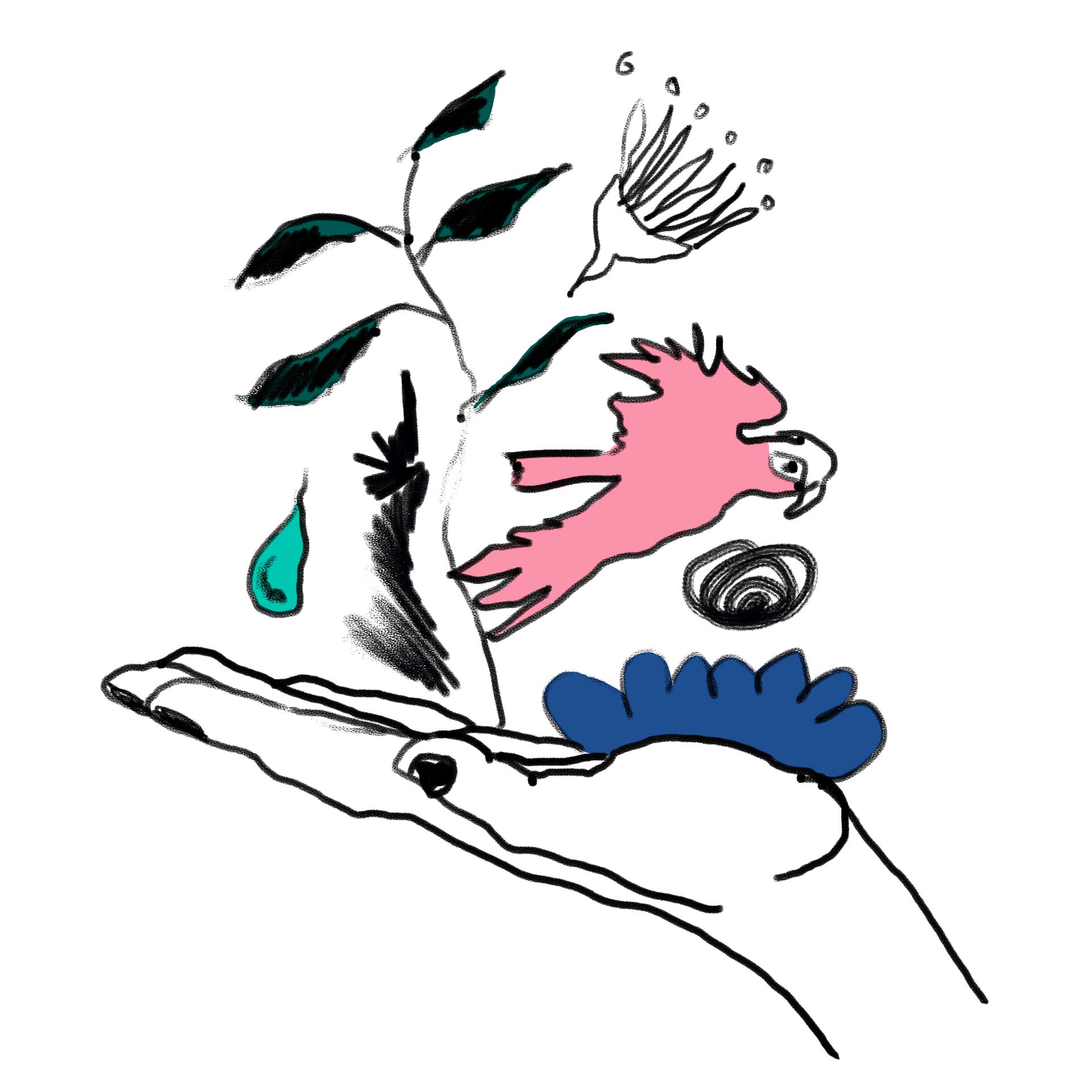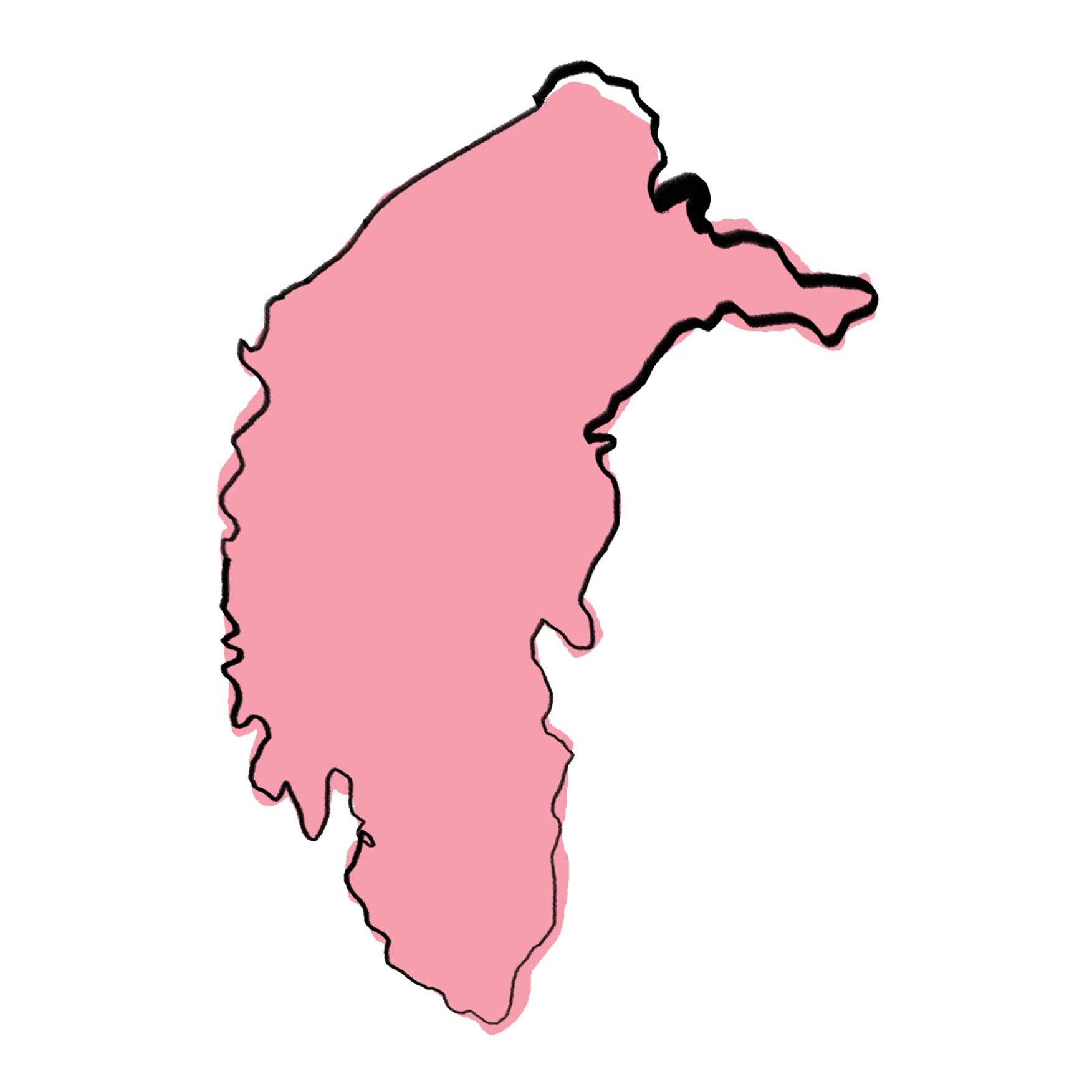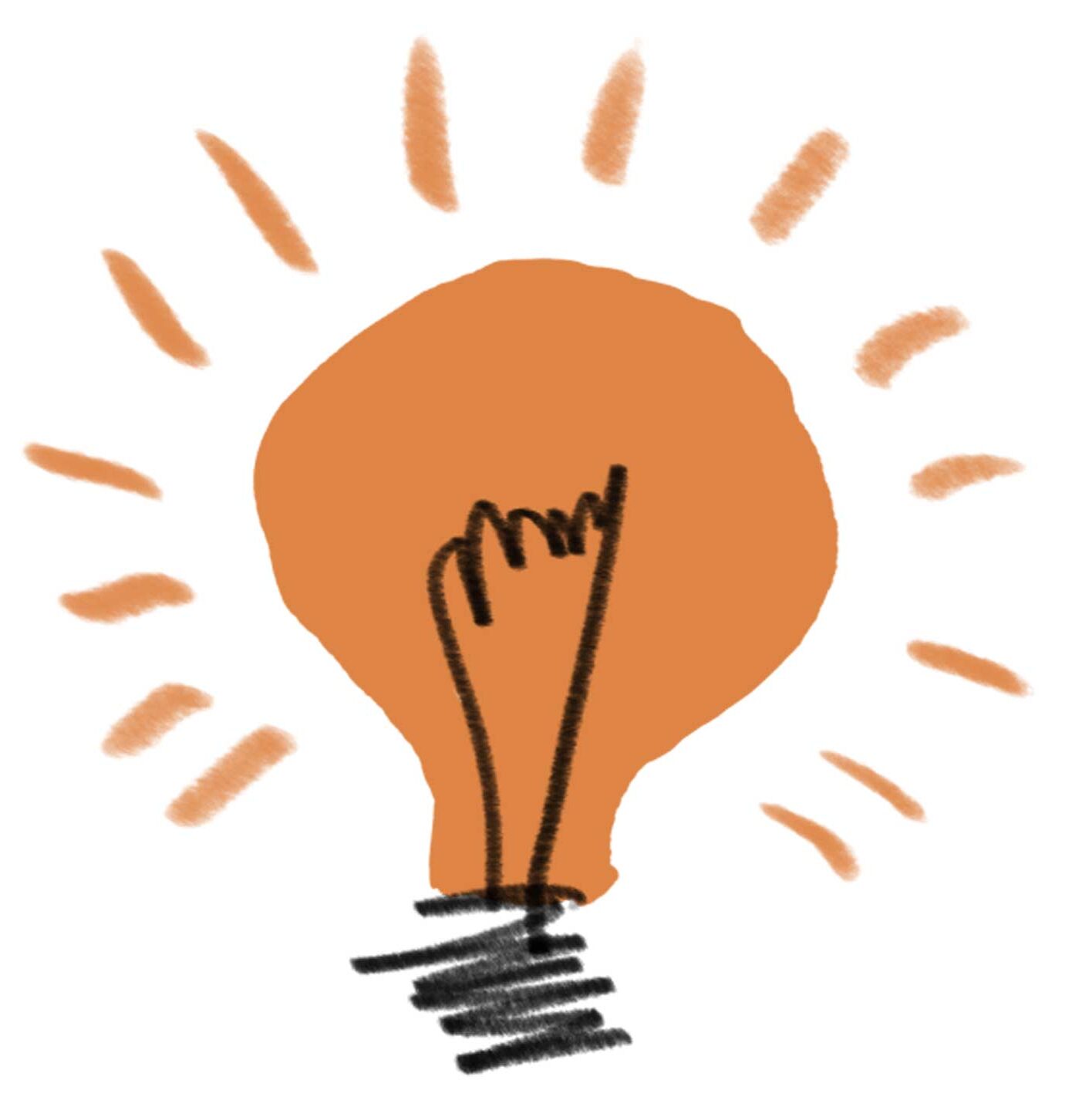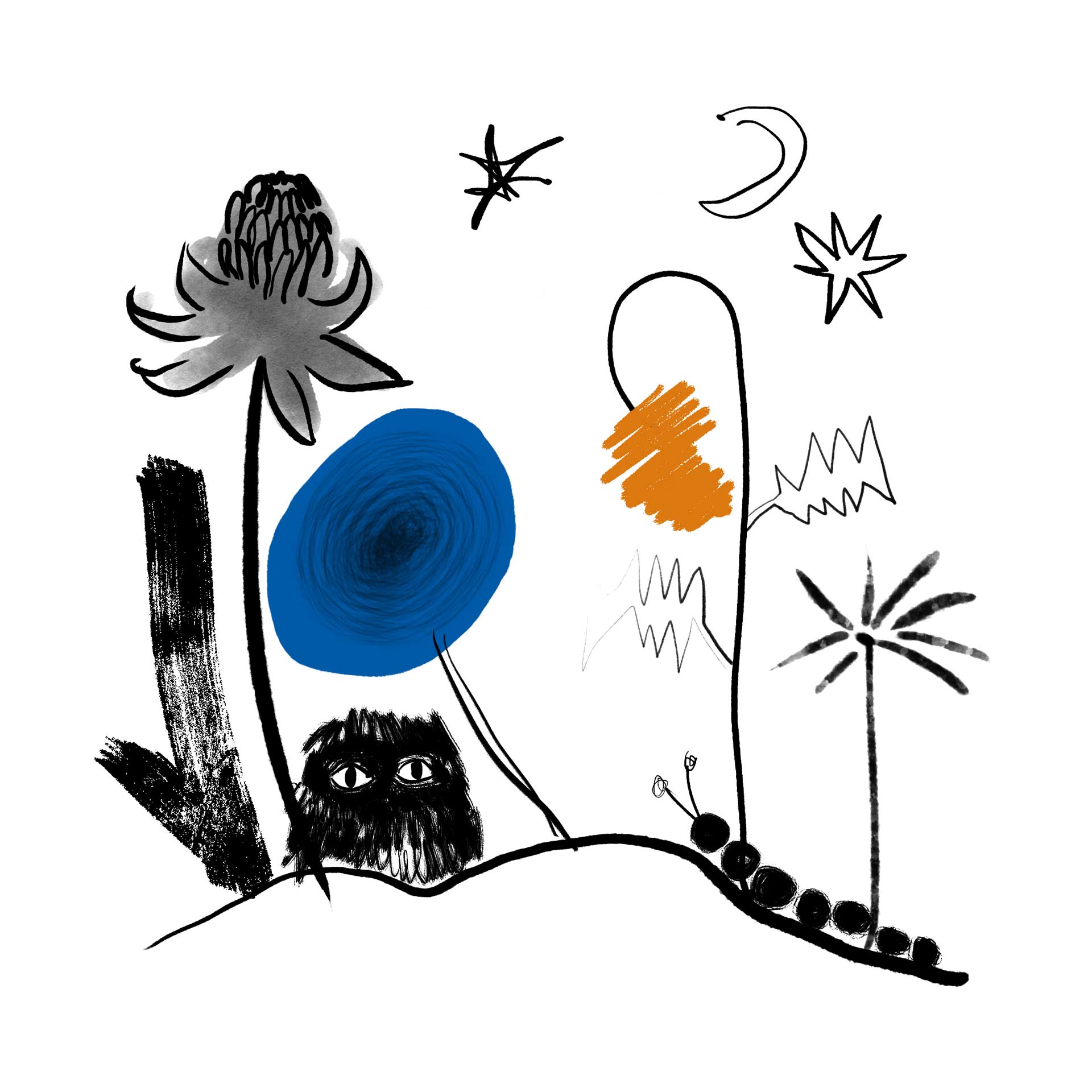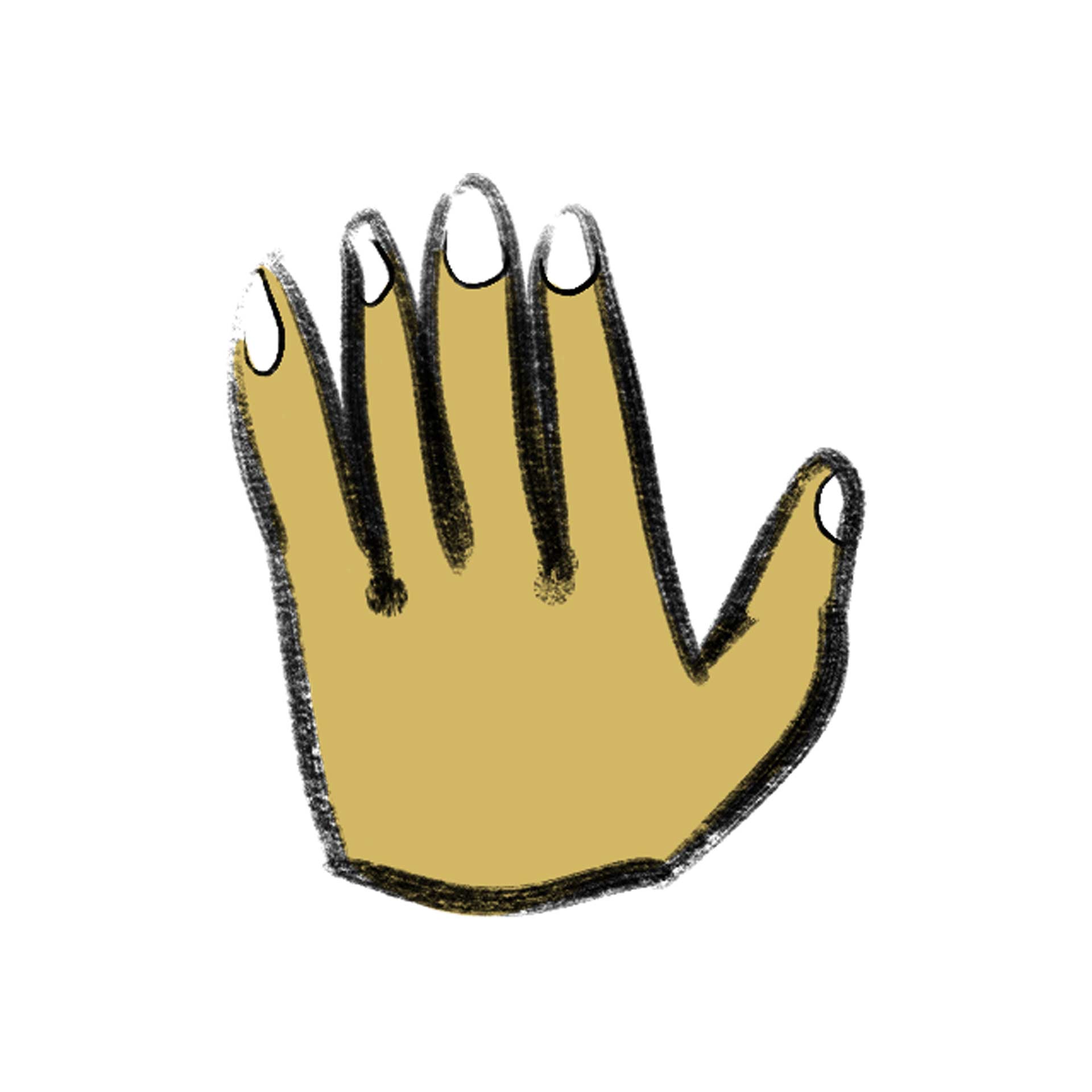biodiversityAll of the different types of life in the environment. It includes plants, animals, and micro-organisms (really small things like bacteria and fungi). is the variety of life.
Should we find out what lives in Canberra?
Click the links below to discover more!

What is biodiversity?
Biodiversity is the variety of plant and animal life in an environment. Biodiversity includes many different types of plants and animals, as well as the types of ecosystems such as forests, grasslands and rivers. Biodiversity is important because living things all interact and need each other to survive.
All living things
There are many living things on our Earth. Some examples are mammals (including people!), fish, insects, birds, plants, bacteria and other life.
Every one of these living things is important. They play different roles in keeping the world healthy. For example, plants provide the oxygen we breath, are food for animals, keep the soil healthy and prevent soil erosionWhen the soil is carried away by water or wind. Soil erosion can reduce biodiversity, harm rivers when soil is washed into waterways, and can create dust storms..
Everything in our world is connected, and each plant and animal is an essential part of our natural ecosystemsA collection of interacting living and non-living things. A forest ecosystem would consist of the trees, grasses, soil, rocks, animals, insects and how each of these things interacts. – that’s why we need to protect biodiversityAll of the different types of life in the environment. It includes plants, animals, and micro-organisms (really small things like bacteria and fungi).. The loss of biodiversityAll of the different types of life in the environment. It includes plants, animals, and micro-organisms (really small things like bacteria and fungi). can damage the health of natural environments.
Healthy biodiversityAll of the different types of life in the environment. It includes plants, animals, and micro-organisms (really small things like bacteria and fungi). is also vital to human health. biodiversityAll of the different types of life in the environment. It includes plants, animals, and micro-organisms (really small things like bacteria and fungi). gives us many benefits including clean air and water, foods and fibres, pollination, control of pests, carbon storageWhen plants remove carbon from carbon dioxide in the air, and turn it into leaves, stems, trunks, and roots. This process also helps to reduce climate change by removing carbon dioxide from the atmosphere., and nutrient cyclingHow nutrients (such as nitrogen) move between plants, animals and bacteria, as well as between soil, water and air..

BiodIvErsity in the ACT
The ACT is home to 2,751 nativeAnimals and plants that live in, and are originally from, an area. The area could be large, like Australia, or it could be small, like a specific national park. animal species and 2,088 nativeAnimals and plants that live in, and are originally from, an area. The area could be large, like Australia, or it could be small, like a specific national park. plant species. But there are also many invasive species that affect native biodiversity and ecosystems in the ACT, including 64 invasive animal species and 592 invasive plant species.

Did you know?
Canberra and surrounds have the richest bird life of any Australian capital city. There are over 200 species here. Birds come in many different sizes and colours, from the large Emu, to the tiny Weebill.
There are also animal species that move through the ACT as they migrate from different areas of Australia and across the world for breeding or feeding.
Most fly from as far away as northern Siberia, China and Japan to spend their summer non-breeding season in Australia.
These species only live in the ACT for a short time each year. This includes around 27 migratory bird species, with 13 being regular visitors.
Species include Latham’s Snipe, Rufous Fantail, Satin Flycatcher, and the White-throated Needletail.


Image: Box Gum Grassy Woodlands by Mark Jekabsons
Endangered species in the ACT
Some of the ACT’s species are endangered need our help. In 2019 there were:
- 7 critically endangered species – a species that is facing an extremely high risk of extinctionWhen an entire species of plant or animal dies out. Once a species becomes extinct, it is gone forever. A species can also be locally extinct, meaning that it has disappeared from an area it once lived in, but still exists elsewhere. in the wild.
- 18 endangered species – species that is facing a very high risk of extinctionWhen an entire species of plant or animal dies out. Once a species becomes extinct, it is gone forever. A species can also be locally extinct, meaning that it has disappeared from an area it once lived in, but still exists elsewhere. in the wild.
- 26 vulnerable – a species that is facing a high risk of extinctionWhen an entire species of plant or animal dies out. Once a species becomes extinct, it is gone forever. A species can also be locally extinct, meaning that it has disappeared from an area it once lived in, but still exists elsewhere. in the wild.
- 3 endangered environments: Natural Temperate Grassland, Yellow Box/Red Gum Grassy Woodland, and High Country Bogs and Associated Fens.
HOW THREATENED AM I?
Meet some of Canberra’s threatened species.

The regent honeyeater (Anthochaera phrygia) is critically endangered.

The superb parrot (Polytelis swainsonii) is vulnerable.

The Northern Corroboree Frog (Pseudophryne pengilleyi) is critically endangered.

The Canberra spider orchid (Caledenia actensis) is critically endangered.

The grassland earless dragon (Tympanocryptis pinguicolla) is endangered.

The murray river (Euastacus armatus) crayfish is vulnerable.
Images: Regent honeyeater and Superb parrot by Ryan Colley, Corroboree Frog by Murray Evans, Grassland earless dragon and Crayfish by Mark Jekabsons
WHAT ARE THE THREATS TO THE ACT’S NATIVE SPECIES?
Threats to biodiversity can occur slowly, such as climate change, or fast, such as a bushfires and land clearing.
The threats to the ACT’s plants and animals are much the same as those facing species across the world. They include:
- ClimateThe usual weather that happens in an area over a long time, usually many years. Climate change is when this usual weather changes. change, especially higher temperatures, more heatwaves and reduced rainfall.
- Increased number of bushfiresA fire that burns in grass, bush or woodland and can threaten life, property and the environment.
- The loss of habitatThe natural home or environment of a plant or animal. from the clearing of trees and other vegetation to make way for homes and farms, and from severe bushfiresA fire that burns in grass, bush or woodland and can threaten life, property and the environment.
- Non-native, or invasivePlants and animals that are not native to Australia. These are also known as introduced species. plants and animals including foxes, rabbits, deer, pigs, uncontrolled cats, and species such as carp in our rivers.
- Overabundant (too many) nativeAnimals and plants that live in, and are originally from, an area. The area could be large, like Australia, or it could be small, like a specific national park. species such as kangaroos, which eat the plants that other species need to survive.
- Not enough water for rivers and wetlandsAreas of land that are covered with shallow water or are waterlogged (wet). These can be seasonal, only existing for short periods of time, or can be permanent..
- Poor water qualityHow clean the water is in rivers, lakes and wetlands. Good water quality has low levels of pollutants. from pollutantsHarmful substances that can damage the environment. Water pollutants include chemicals, fertilisers, bacteria, viruses, animal or human waste, and too many nutrients. and the use of toxic chemicals. Poor water qualityHow clean the water is in rivers, lakes and wetlands. Good water quality has low levels of pollutants. can lead to the loss of plants and animals reducing biodiversityAll of the different types of life in the environment. It includes plants, animals, and micro-organisms (really small things like bacteria and fungi)..

What can we all do to help our plants and animals?
- Put your rubbish in bins so that nativeAnimals and plants that live in, and are originally from, an area. The area could be large, like Australia, or it could be small, like a specific national park. species don’t eat plastic and it doesn’t end up in rivers.
- Plant more nativeAnimals and plants that live in, and are originally from, an area. The area could be large, like Australia, or it could be small, like a specific national park. species in your garden or at a local reserve through a community tree-planting program – see become a volunteer for more information.
- Do not take firewood from conservation reserves. These are places where the land is kept natural to care for nature and provide a place for plants to grow and animals to live. Trees, including dead ones and fallen branches, all provide important habitatThe natural home or environment of a plant or animal. and are protected.
- When you travel interstate or come back from overseas, make sure that you don’t bring plant or animal material back to Canberra.
- Put a bell on your cat and follow the cat laws; keep your cat indoors as much as possible, or have an outdoor cage.
- Protect more areas for plants and animals, so our nativeAnimals and plants that live in, and are originally from, an area. The area could be large, like Australia, or it could be small, like a specific national park. wildlife has a safe place to live.
- Protect older trees with hollows for animals.
- Plant more nativeAnimals and plants that live in, and are originally from, an area. The area could be large, like Australia, or it could be small, like a specific national park. vegetation to provide new habitatThe natural home or environment of a plant or animal. and wildlife corridors that allow species to move from one place to another.
- Protect grasslands and woodlands from being cleared.
- Control the numbers of invasivePlants and animals that are not native to Australia. These are also known as introduced species. and overabundant nativeAnimals and plants that live in, and are originally from, an area. The area could be large, like Australia, or it could be small, like a specific national park. species.
- Talk to others about how important it is to look after our plants and animals.
- Put out water for wildlife when there is a drought, or the weatherThe sun, rain, or wind that you experience every day. is very hot.

BECOME A VOLUNTEER
A hands-on way to help biodiversityAll of the different types of life in the environment. It includes plants, animals, and micro-organisms (really small things like bacteria and fungi). is to join a local volunteer community group that helps animals and plants.
Note that most volunteering opportunities in the ACT will require you to be accompanied by someone over the age of 18.
Here are some to get you started:
- Parkcare
- Landcare
- Greening Australia
- Urban Parks and Places Volunteering
- WaterWatch
- Frogwatch
- Canberra Ornithologists Group
- Participate in citizen science through the Canberra Nature Map
- ACT Wildlife
- Friends of Grasslands
- ACT Young Rangers Club
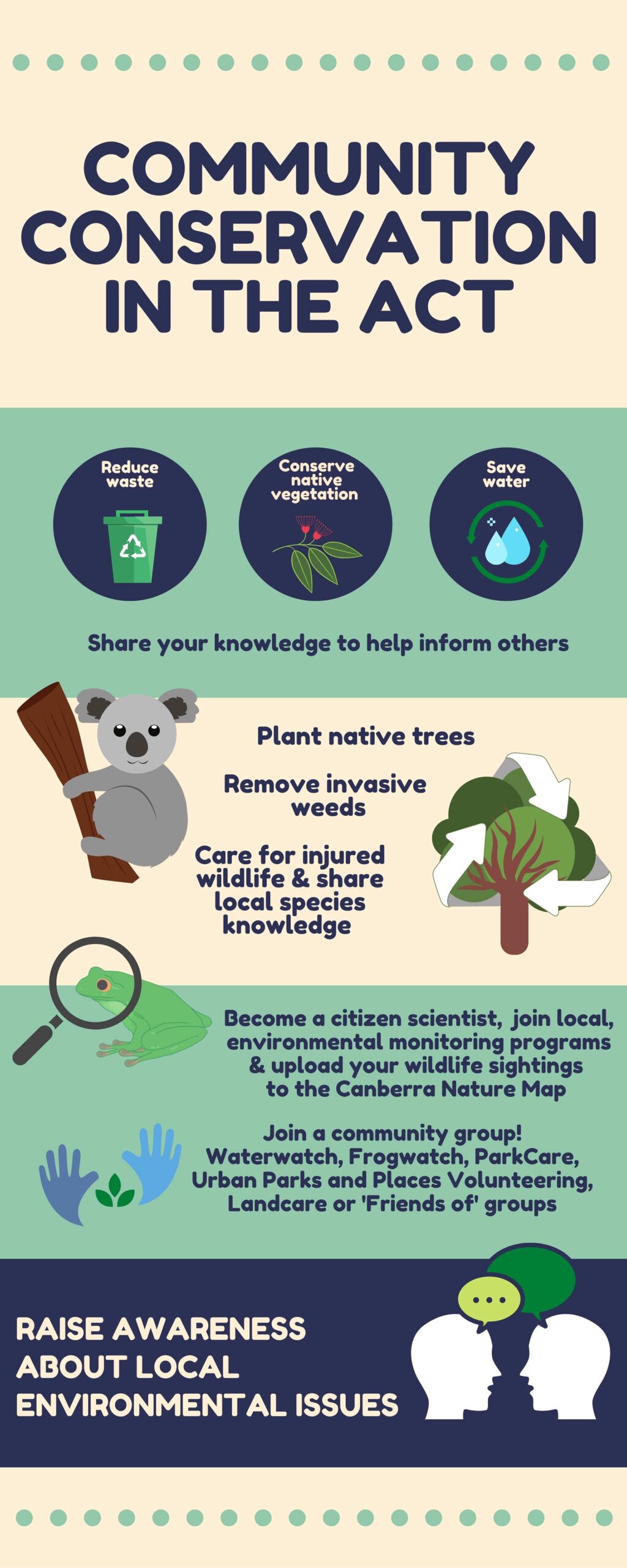

LET’S GET OUTSIDE
Become a citizen scientist!
Scientists have a lot of work to do, and sometimes need help monitoring where plants and animals are and how many of them exist. You can help them out by getting outside and using these apps and websites:
- Complete a Backyard Birdcount.
- Look for frogs in your local waterways and ponds using the Frog ID app.
- Take photos of plants and animals you see and upload them to Canberra Nature Map so an expert can identify the species for you.
Activities
MAKE YOUR LAWN ATTRACTIVE TO NATIVE BEES
Bees are important as they help support biodiversity by pollinating plants and allowing them to grow. About a third of Australia’s food production relies on bees. You can choose plants for your garden that are good for bees, such as Grevillea and Hakea species.
You can also plant flowers in your lawn to help bees – and reduce the area of lawn to mow, too.
Plants such as clover, dandelion, thyme and daisies (available at local nurseries) require little upkeep and watering, making them perfect for Australia’s dry ClimateThe usual weather that happens in an area over a long time, usually many years. Climate change is when this usual weather changes..
When mowing the lawn, don’t use the grass catcher – allow the grass clippings to fall back onto the lawn, as this helps to fertilise it.
This means the grass can grow deeper, stronger roots and the soil also becomes healthier.

A green investigation
How connected (or not connected) are the green spaces around you?
This activity demonstrates how urban development can break up natural habitats. Changes to land use can impact on biodiversity as many species cannot move to other areas to find new places to live, food to eat, or opportunities to breed.
Look up your home address on Google maps, then zoom out so that you can see a few suburbs. Think about the following questions:
- How much green space do you see in your immediate neighbourhood?
- Can you trace your finger over the screen from green space to green space without lifting your finger?
- Does the size of the green spaces change?
- Are there green spaces near water (rivers, creeks, wetlandsAreas of land that are covered with shallow water or are waterlogged (wet). These can be seasonal, only existing for short periods of time, or can be permanent., lakes)?
- Are there roads that break up green spaces?
- Can you see areas that could be improved by creating new greenspace and wildlife habitatThe natural home or environment of a plant or animal.?
Considering these questions can help you learn how much (or how little) green space we have around us. Large patches are better than small ones, and connected green spaces are better than divided ones.

Canberra has quite a lot of green space, but sometimes it is not connected well enough for species to move about. Creating new habitatThe natural home or environment of a plant or animal. to connect isolated areas can help species move between patches of land. If species are able to stay connected, biodiversityAll of the different types of life in the environment. It includes plants, animals, and micro-organisms (really small things like bacteria and fungi). will be greater. When roads run through conservation areas, animals can’t get across the road, or they may be hit by cars while trying. Constructing overhead bridges or underground tunnels can help animals to move safely.
HELP NEW PLANTS GROW IN YOUR GARDEN
This activity demonstrates how urban development can break up natural habitats. Changes to land use can impact on biodiversity as many species cannot move to other areas to find new places to live, food to eat, or opportunities to breed.
Seed bombs are like bath bombs – but for your garden! They are a great way to make gardening fun and look after the land. Seed bombs can be especially helpful in areas where the land has been eroded and damaged. Normal seeding methods involve scattering seeds on the topsoil. But this leaves seeds vulnerable to being baked by hot sun, washed away by heavy rains, blown away by the wind, or eaten by animals and insects. Seed balls protect seeds from many of these threats and can help plants thrive.
What do I need?
- 2 parts potting soil
- 5 parts clay mix
- water to moisten the mixture
- 1-2 parts nativeAnimals and plants that live in, and are originally from, an area. The area could be large, like Australia, or it could be small, like a specific national park. seeds (your local nursery can tell you what seeds are the best to plant in your area)
- large tray or a cardboard box
What do I do?
Mix the soil, clay and some water. Add the water slowly, as you don’t want your mixture to be too wet and gluggy; it should be just moist enough to stick together.
Add the seeds and knead them through the mixture until well mixed.
Take a small amount of your seed-dirt mixture and roll it in the palm of your hand to create a ball. If the ball doesn’t stick together and falls apart, add a little more water. Be gentle when you roll the balls: you want them to stick together but you don’t want to compact the soil too much. The ball needs to break apart when it gets wet in the garden.
Place your rolled balls onto the large tray or into a cardboard box. Store them in a dry, cool, shady place for a day or so.
Scatter your seed bombs around the garden where you want nativeAnimals and plants that live in, and are originally from, an area. The area could be large, like Australia, or it could be small, like a specific national park. plants to grow.
There is no need to water them or bury them, just let the earth do its thing!
Tip: You could organise to do this with a Landcare group and scatter seed bombs at a local reserve.
Remember that most volunteering opportunities in the ACT will require you to be accompanied by someone over the age of 18.
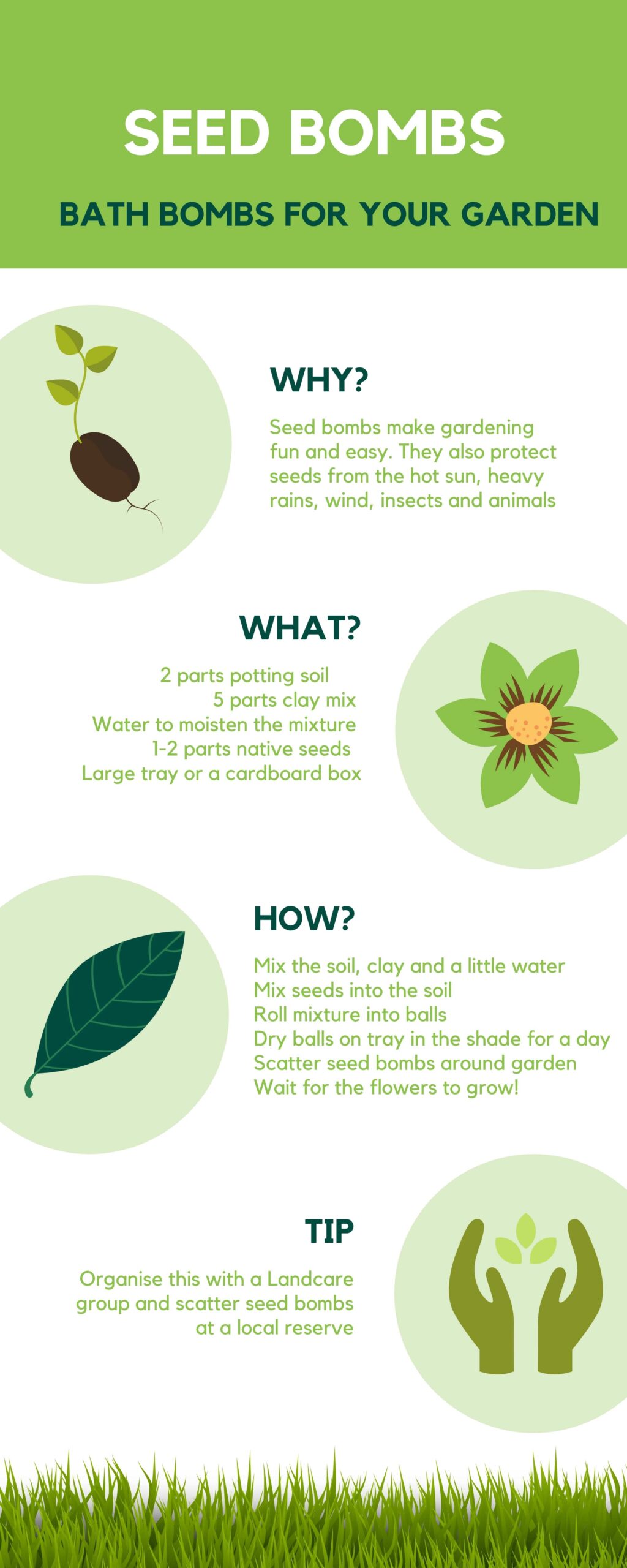
Match me to my home
This activity improves our general knowledge about our threatened species and their habitat. See if you can match the endangered species to their habitat. Hint, if you don’t know the answer, you can search online! Once you think you know the answer, click on the card to see if you are right.
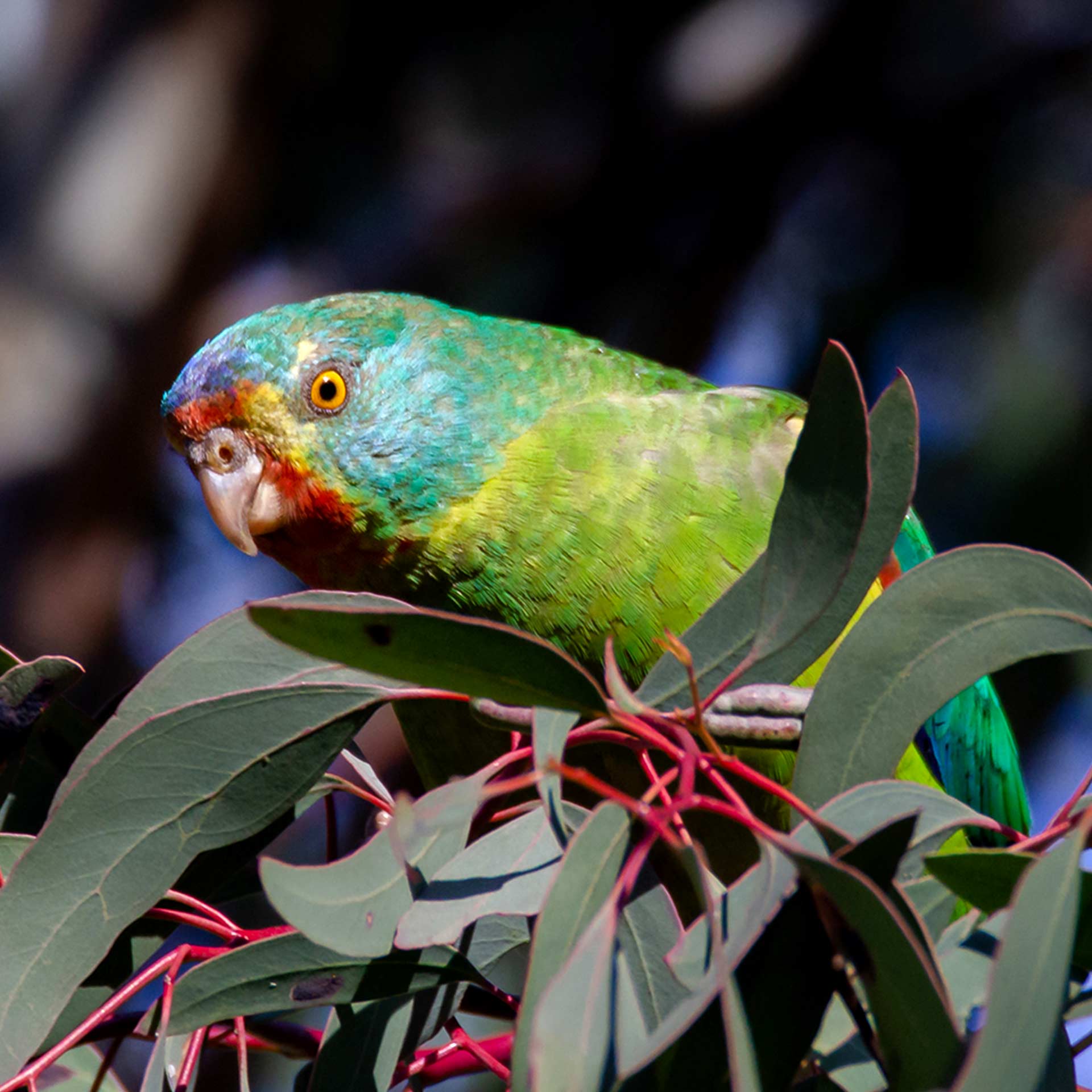
Flowering trees and woodlands

Alpine/Mountain bogs and fens

Woodlands and open forest

Rocky landscapes

Forest

Grassland
Images: Swift parrot by Ryan Colley, Corroboree Frog by Murray Evans, Grassland earless dragon by Mark Jekabsons
MAKE A BOOKMARK
This activity improves our knowledge of what we can do to help our native plants and animals.
What do I need?
Click here to download and print out a help biodiversityAll of the different types of life in the environment. It includes plants, animals, and micro-organisms (really small things like bacteria and fungi). bookmark, or make your own.
In each bubble, write something you can do every day to help biodiversityAll of the different types of life in the environment. It includes plants, animals, and micro-organisms (really small things like bacteria and fungi). on our planet!
Spot the invasive species
This activity increases knowledge on invasive species and their impacts on our environment. Look at the picture pairs below. One is an important native species in the ACT, and the other is an invasive species that is threatening the native species. Choose the one you think is the invasive species, then click on the card over to reveal the answer. When you turn over the invasive species picture there is some information about why they are a problem in the ACT.

Native species: Smoky mouse

Invasive species: House mouse
These mice can breed often and can invade houses in large numbers.

Invasive species: African lovegrass
This invasivePlants and animals that are not native to Australia. These are also known as introduced species. grass species is threatening the survival of Grassland Earless Dragons. The grass grows so thickly that it stops the dragons from moving between their habitatThe natural home or environment of a plant or animal. and food sources.

Native species: Grassland Earless Dragon

Invasive species: St John’s Wort
St John’s Wort is not a weed everywhere in the world, but in the ACT it can spread and take over, so nativeAnimals and plants that live in, and are originally from, an area. The area could be large, like Australia, or it could be small, like a specific national park. plants can’t grow. It is very tough and can grow in difficult conditions such as areas with low amounts of rainfall and nutrientsElements such as nitrogen and phosphorus. Too many nutrients in water can cause large amounts of algae to grow harming other plants and animals. in the soil, which is why it can spread easily.

Native species: Button Wrinklewort

Native species: Pale Pomaderris

Invasive species: Blackberry
Blackberries can survive without much water and can grow until they take over an area, stopping other plants from growing there.

Native species: High country bogs/mosses

Invasive species: Horses, cattle, pigs, deer
Hard hoofed animals destroy delicate mosses. Mosses are important for holding water and are habitatThe natural home or environment of a plant or animal. for species such as frogs.

Invasive species: Carp
Carp affect nativeAnimals and plants that live in, and are originally from, an area. The area could be large, like Australia, or it could be small, like a specific national park. fish species by eating their food and using their habitatThe natural home or environment of a plant or animal..

Native species: Macquarie Perch
Grassland earless dragon by Mark Jekabsons, High country bogs by Mark Jekabsons, Macquarie Perch by E. Beaton

